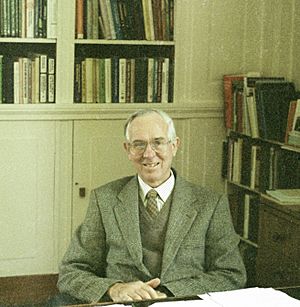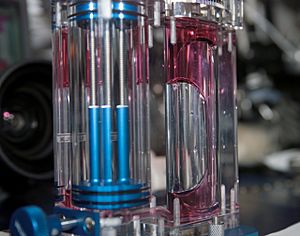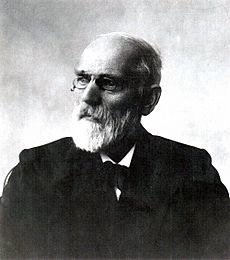John Shipley Rowlinson facts for kids
Quick facts for kids
Sir
John Shipley Rowlinson
|
|
|---|---|

J. S. Rowlinson in his office in June 1991
|
|
| Born | 12 May 1926 Handforth, Cheshire, England
|
| Died | 15 August 2018 (aged 92) |
| Nationality | British |
| Awards | Faraday Lectureship Prize (1983) |
| Scientific career | |
| Institutions | Imperial College London University of Oxford |
Sir John Shipley Rowlinson (born May 12, 1926 – died August 15, 2018) was an important British chemist. He studied at Oxford University, finishing his first degree in 1948 and his advanced degree in 1950.
After his studies, he worked at several famous universities. He was a researcher at the University of Wisconsin from 1950 to 1951. Then, he taught at the University of Manchester from 1951 to 1961. He became a professor at Imperial College London from 1961 to 1973. Later, he returned to Oxford in 1974 and worked there until he retired in 1993.
Sir John studied many different science topics. He was especially interested in capillarity and cohesion. Capillarity is how liquids can move up in narrow spaces, like water climbing up a thin tube. Cohesion is the force that makes similar molecules stick together. He also wrote about the history of science. This included many books and papers about a Dutch physicist named Johannes Diderik van der Waals. Sir John was a member of the Royal Society and the Royal Academy of Engineering. He received a special award called the Faraday Lectureship Prize in 1983. He was also made a knight in 2000, which means he received the title "Sir".
Contents
Early Life and Education
John Rowlinson was born in Handforth, Cheshire, England, on May 12, 1926. He went to a school called Rossall School in Fleetwood. After that, he studied at Trinity College, Oxford. In 1944, he won a special scholarship to study chemistry there.
His teacher at Oxford was Professor Sir Cyril Hinshelwood. Sir Cyril was the first head of the Physical Chemistry Laboratory. John finished his first degree with top honors in 1948. He then continued his studies at Oxford. In 1950, he earned his D.Phil. degree in a field called chemical kinetics. He worked with a scientist named J. D. Lambert for this research.
A Career in Chemistry
In 1950, John Rowlinson received a Fulbright scholarship. This allowed him to become a research associate at the University of Wisconsin in Madison, USA. There, he joined a team led by Joseph O. Hirschfelder. He worked with another scientist, C. F. Curtiss, on various topics in physical chemistry.
In 1951, he moved back to England. He started working at the University of Manchester as a Fellow. Later, he became a lecturer and then a senior lecturer at the same university.
Becoming a Professor
In 1961, Rowlinson was chosen to be a Professor of Chemical Technology at Imperial College London. He was recognized for his excellent work in 1970 when he became a Fellow of the Royal Society. This is a very high honor for scientists in the UK.
In 1974, he moved back to Oxford University. He became the Dr Lee's Professor of Chemistry. In 1976, he was also made a Fellow of the Royal Academy of Engineering. This shows his importance in both science and engineering.
Awards and Retirement
Sir John received the Faraday Lectureship Prize in 1983. This award is given for amazing contributions to physical or theoretical chemistry. He retired from his teaching role in 1993. After retiring, he became an Emeritus Fellow of Exeter College, Oxford. Even after retirement, he kept writing scientific papers. He was knighted in the year 2000, which means he became "Sir John". In 2008, he received another award, the Sidney M. Edelstein Award. This award was for his great work in the history of chemistry.
What Sir John Studied

Throughout his career, Sir John Rowlinson wrote over 200 papers and book chapters. He studied many different things, but his main interests were capillarity and cohesion. Capillarity is how liquids move in small spaces. Cohesion is the force that makes molecules of the same type stick together.
His book, Molecular Theory of Capillarity, was co-written with Benjamin Widom in 1982. This book is very important in science and engineering. By 2010, it had been mentioned in over 2,000 other scientific papers. His earlier book, Liquids and Liquid Mixtures (1958), is also very popular. Benjamin Widom called it a "classic" book.
In 2002, he wrote another praised book called Cohesion. This book explained how forces between molecules work. It also covered the history of these ideas and how they affect matter. He also helped write a textbook called Thermodynamics for Chemical Engineers in 1975. Other science topics he wrote about include how things change from one state to another (like ice to water), how computers can simulate interfaces, and even glaciers.

Besides his technical science work, Sir John also wrote about the history of science. He started writing about this topic in 1973 with a paper called The Legacy of van der Waals. He continued to write more about Johannes Diderik van der Waals. This included translating van der Waals' advanced degree paper in 1988. He also wrote a biography of the Dutch physicist in 1996. His colleague, Benjamin Widom, said the translation was "a masterwork". He also called the introduction "brilliant". His book Molecular Theory of Capillarity also included the history of the topic.
Sir John also helped manage science in the United Kingdom. He helped expand the physical chemistry research at Oxford. He also supported the teaching of the history of science there. He was a big supporter of the collection at the Museum of the History of Science, Oxford. He was also the editor of a science journal called Molecular Physics.
Personal Life
Sir John Rowlinson loved to climb mountains. He regularly climbed in the Swiss Alps and also climbed in the Himalayas. He was an active member of the Exeter College community at Oxford. He often went to their lunches and events for former students. He passed away on August 15, 2018.

